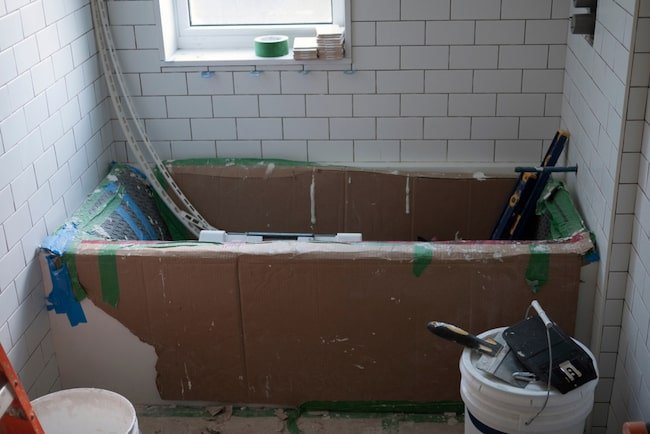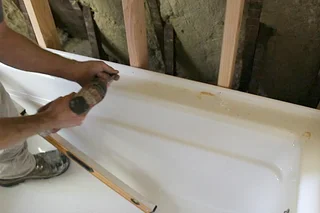We've noticed this post pertaining to How to Install a Bathtub: Install an Acrylic Tub and Tub Surround directly below on the web and concluded it made sense to discuss it with you on this page.

Mounting a bathtub isn't precisely brain surgery, but it does need strong plumbing, carpentry, as well as occasionally, tiling skills. Replacing an old tub with a brand-new one is likewise a reasonably challenging task. If the old tub is easily easily accessible, the project can move speedily; if you need to open a wall surface to eliminate the old bathtub and place the brand-new bathtub, the job is a lot harder. In either situation, the job is within a home handyman's skills, although you will certainly need an assistant to move out the old tub and also set in the new one. Make certain you have actually certified on your own for the job as well as fit attempting it. As opposed to employing a service provider to take over a halfway-completed job, it is far better to consider employing one prior to you start. Chances are you may require a specialist plumber to make tube links.
This short article will certainly aid you install a new bathtub in your restroom if you have already gotten a brand-new bathtub and don't need to alter the plan of your previous water pipes.
Your tools as well as product list should comprise the following:
Removing Old Taps
If you need to replace old faucets with new ones as a part of your installation, then the first thing you ought to do is detach the water system. After doing so, activate the faucets to drain pipes any kind of water remaining in the system. The process of removing the existing taps can be quite troublesome because of the limited gain access to that is typically the case.
Use a basin wrench (crowsfoot spanner) or a faucet device to reverse the nut that connects the supply pipelines to the taps. Have a fabric ready for the remaining water that will certainly originate from the pipelines. When the supply pipes have been gotten rid of, utilize the exact same tool to loosen up the nut that holds the taps onto the bath/basin. You will require to quit the single taps from transforming during this procedure. When the taps have actually been gotten rid of, the holes in the bath/basin will need to be cleaned up of any kind of old sealing compound.
Prior to proceeding to fit the brand-new taps, compare the pipeline connections on the old faucets to the brand-new taps. If the old faucets are longer than the brand-new taps, after that a shank adapter is needed for the new taps to fit.
Suitable New Taps
If the tails of the new taps are plastic, after that you will need a plastic adapter to stop damages to the string. One end of the port fits on the plastic tail of the tap and also the various other end supplies a connection to the current supply pipes.
If you need to fit a monobloc, after that you will call for minimizing couplers, which connects the 10mm pipeline of the monobloc to the common 15mm supply pipe.
Next off, position the faucet in the installing hole in the bath/basin making certain that the washers remain in place in between the tap and also the sink. Secure the faucet in place with the maker offered backnut. As soon as the tap is firmly in place, the supply pipelines can be connected to the tails of the faucets. The taps can either be linked by using corrugated copper piping or with typical faucet ports. The previous type must be connected to the faucet finishes first, tightening just by hand. The supply pipes can later be attached to the other end. Tighten both ends with a spanner after both ends have actually been connected.
Mounting the Bathtub
Utilizing the two wooden boards under its feet, position the bathtub in the called for placement. The wooden boards are valuable in evenly spreading the weight of the bath tub over the area of the boards rather than focusing all the weight onto 4 tiny points.
The next objective is to guarantee that the bathtub is leveled all round. This can be achieved by examining the level and changing the feet on the bathtub until the level checks out degree.
To install taps, fit all-time low of the furthest flexible faucet port to the suitable supply pipe by making a compression sign up with; then do the same for the other tap.
Turn on the water supply and inspect all joints and also brand-new pipework for leaks as well as tighten them if needed. Load the bathtub and likewise inspect the overflow electrical outlet and also the regular electrical outlet for leaks.
Finally, repair the bath paneling as explained in the supplier's user's manual. Tiling and sealing around the bathtub ought to wait up until the tub has actually been utilized at the very least when as this will certainly resolve it into its final position.
Getting ready for the Setup
First of all, the sustaining framework provided with the bathroom must be fitted (if called for) according to the manufacturer's instructions. Next, fit the faucets or mixer to the bath tub. When suitable the faucet block, it is necessary to see to it that if the faucet includes a plastic washing machine, it is fitted between the bath as well as the taps. On a plastic bath, it is also sensible to fit a supporting plate under the taps device to stop pressure on the bath tub.
Fit the adaptable faucet ports to the bottom of the two taps using 2 nuts and olives (occasionally provided with the bathtub). Fit the plug-hole electrical outlet by smearing mastic filler round the sink electrical outlet opening, and afterwards pass the outlet through the hole in the bath. Make use of the nut provided by the maker to fit the plug-hole. Take a look at the plug-hole outlet for an inlet on the side for the overflow pipe.
Next, fit completion of the versatile overflow pipe to the overflow outlet. After that, screw the pipeline to the overflow face which must be fitted inside the bath. Make sure you make use of every one of the supplied washers.
Link the catch to the bottom of the waste outlet on the bath tub by winding the string of the waste outlet with silicone mastic or PTFE tape, and also screw on the catch to the outlet. Connect all-time low of the overflow tube in a comparable manner.The bath ought to currently prepare to be fitted in its final position.
Tiling Around the Bath tub
In the area where the bathroom fulfills the floor tile, it is necessary to seal the joins with a silicone rubber caulking. This is essential as the installation can relocate enough to crack an inflexible seal, triggering the water to penetrate the wall surface between the bathroom as well as the tiling, leading to issues with moisture and possible leaks to the ceiling below.
You can choose from a selection of coloured sealants to assimilate your fixtures and installations. They are sold in tubes and also cartridges, and can sealing spaces approximately a width of 3mm (1/8 inch). If you have a larger space to load, you can fill it with twists of drenched paper or soft rope. Bear in mind to constantly fill the tub with water prior to sealing, to allow for the motion experienced when the tub remains in usage. The sealant can break relatively very early if you do not take into account this movement before securing.
Conversely, ceramic coving or quadrant floor tiles can be used to edge the bath or shower tray. Plastic strips of coving, which are easy to use as well as reduce to dimension, are likewise conveniently readily available on the marketplace. It is suggested to fit the ceramic tiles using water-resistant or water resistant sticky as well as grout.
Bathtub Installation
How Important Is A Bathtub To Your Home?
High-quality baths, showers, and other bathroom updates are necessary when considering a smart investment in your home. It’s a room that you go to every day and one that is constantly being used by guests.The bathroom is one of the top trafficked rooms in a home and also one of the most valuable in terms of home resale.
Install Piping Before Tub
You will be using your existing drain and waste vent system, but pipes required include the hot and cold water supply lines and a pipe leading to a shower head. A mixing valve and shower head are also needed. Air chambers may be required.
Position the Tub
Lower the tub into place so that the continuous flange fits against the wall studs and rests on 1’x4' or 2’x4' supports. Anchor the tub to the enclosure with nails or screws inserted through the flanges into the studs.
NOTE: Remember, bathtubs and shower stalls may require support framing. A bathtub filled with water is extremely heavy, so check building codes and framing support before installing the tub.
Assemble Drain Connections
Assemble the bathtub drain connections by connecting the tub overflow with the tub drain above the trap, not beyond it. The trap will have a compression fitting that screws over the arm of the overflow assembly.
Place a Pipe For the Shower Head
First, locate a brass female threaded winged fitting and attach it to a framing support via a screw or a nail. Then run a pipe up the wall for the shower head. Sweat or solder the other side of the brass fitting to the top of the pipe.
Attaching Hot and Cold Water Lines
Attach your water lines for both hot and cold by sweating these directly into the hot and cold ports of the mixing valve. The mixing valve will be how water enters the tub’s system, not by the pipes themselves.
Install the Spout
Extend a piece of 1/2 inch pipe, or whichever length is specified in the manufacturer’s instructions, for the tub spout. Sweat on a male threaded fitting at the end of the pipe or use a brass nipple of the proper length and a 1/2 inch cap.
NOTE: At this point you should have your rough-in plumbing work inspected before proceeding further.
Check For Leaks
Restore the water pressure and check the drain connection and the supply pipes for any sign of leaking.
estore the Bathroom Wall
Replace the wall with moisture-resistant drywall as a base for your wall covering. Seal the joints between the wall and your new tub with silicone caulk as protection against water seepage.
https://www.berkeys.com/2016/12/02/bathtub-installation-dallas/

Do you like reading about How to Install a Bathtub? Post a remark down the page. We will be pleased to listen to your thinking about this write up. In hopes that you come back again in the near future. Sharing is caring. Who knows, you might be helping someone out. I am grateful for your time. Come back soon.
Schedule An Appointment
 Amanda Bynes Then & Now!
Amanda Bynes Then & Now! Molly Ringwald Then & Now!
Molly Ringwald Then & Now! Joshua Jackson Then & Now!
Joshua Jackson Then & Now! Kenan Thompson Then & Now!
Kenan Thompson Then & Now! Phoebe Cates Then & Now!
Phoebe Cates Then & Now!